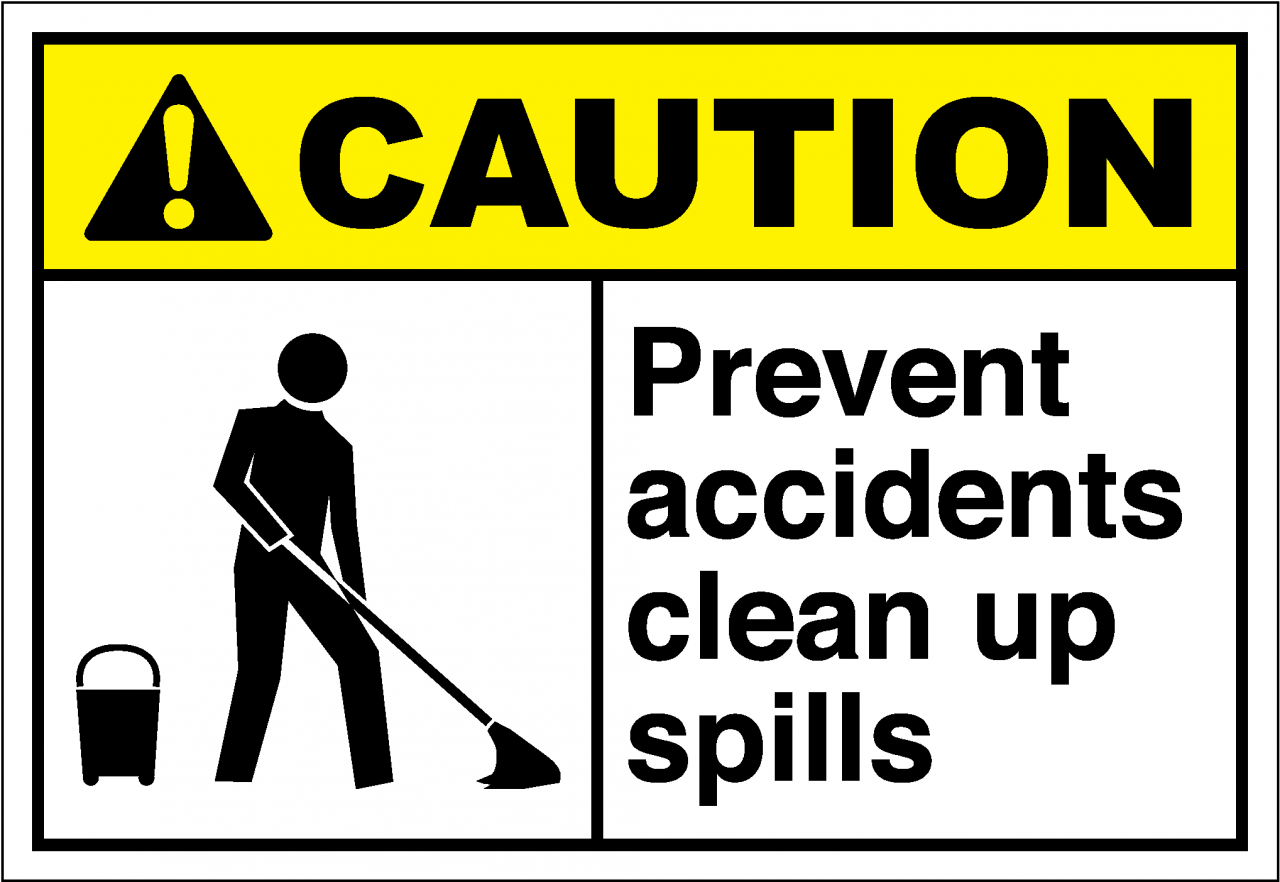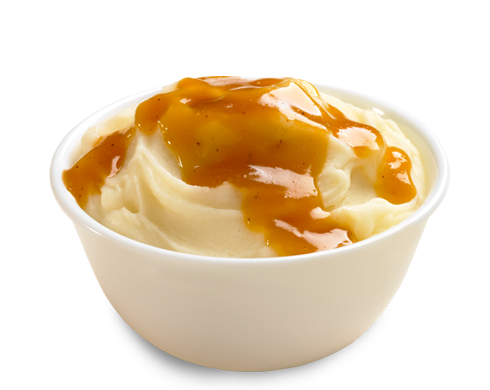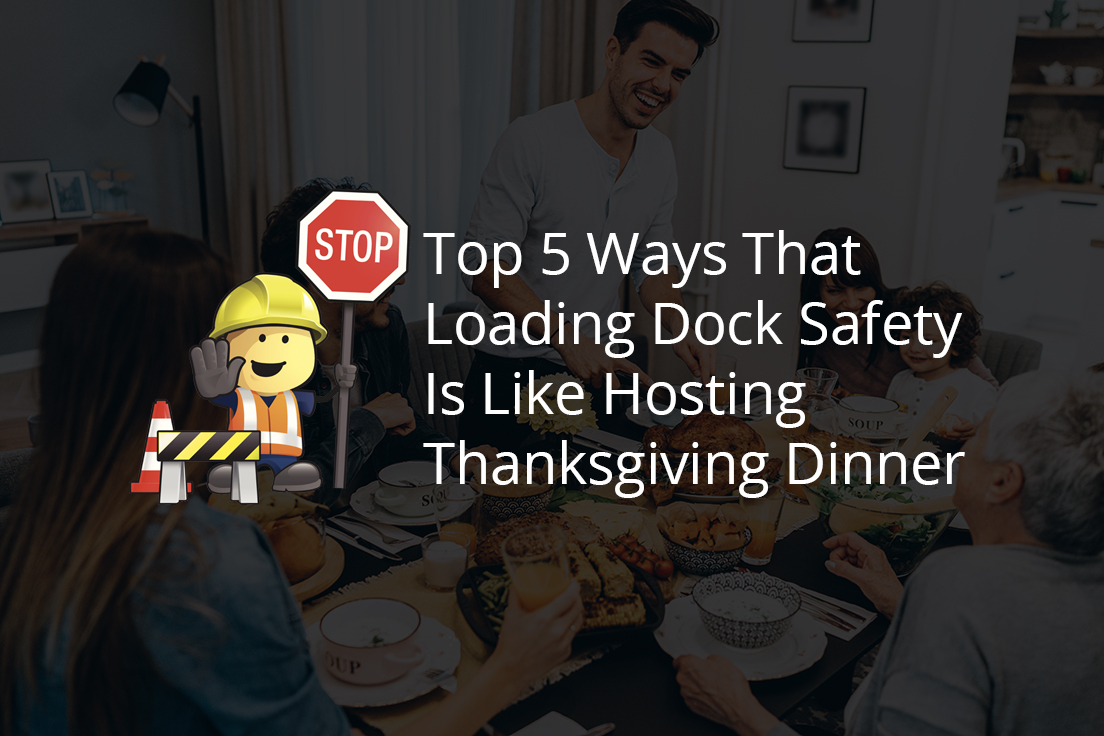There’s no question that the loading dock can be a hazardous place, which is why most manufacturers take loading dock safety pretty seriously. Not unlike the loading dock, hosting Thanksgiving Dinner for your friends and family can be pretty hazardous too.
In the spirit of the upcoming holiday, we thought it might be fun to compare the two and see if there might be some common ground between loading dock safety and hosting Thanksgiving Dinner.
1. Using Barriers to Prevent Falls
Loading docks are often elevated four feet or higher off the ground, and ramps, dockboards, and other bridge devices are used to load and unload vehicles. In many cases, dock doors are left open for ease of traffic, ventilation, and to let in light.
That presents a falling hazard.
Scissor gates, chains, railings, or other visual barriers must be in place any time the overhead door is open and there is a fall hazard. That way no one falls through the dock door.
So how can this possibly relate to hosting Thanksgiving Dinner?
Presumably, you don’t have a dock door at your house.
Just because you don’t have a dock door, doesn’t mean that you don’t have any falling hazards, especially for young children and the elderly. An open door to a basement, a lowered garage, or a sunken room can spell disaster for Grandma or your sister’s toddler. Put up a baby gate, keep the door closed, or find some other creative way to minimize the risk of falls.
No one wants to take Grandma to the emergency room on Thanksgiving because she backed through a doorway and rolled down the basement stairs.
2. Good Housekeeping
Loading dock safety and good housekeeping go hand in hand. With such large volumes of materials going in and out, keeping things clean and clutter free helps to make things safer for everyone. It’s also really important to keep spills and tracked in water cleaned up to prevent slips and falls. This can present a challenge during inclement weather.
Good housekeeping is also important when you’re hosting Thanksgiving at your house.
Obviously, your house better be clean for the event. No one wants to hear Great Aunt May talk about how dirty your house is with a “I guess they just have different priorities” said under her breath (eye roll). But there’s more to it than that.

- Keeping things clutter free means that guests won’t trip or inadvertently break your stuff.
- Keeping spills mopped up means that sticky Kool-Aid or juice won’t get tracked throughout the house.
- Putting extra towels or mats around the front door, when the weather is wet and snowy, may help keep muddy footprints from magically appearing across your living room carpet.
Good housekeeping is important for loading dock safety and hosting Thanksgiving.
3. Make Sure Everyone Knows What They’re Doing
No matter what an employee’s role at a loading dock, they must be properly trained. Machinery operators have a long list of Occupational Safety and Health Administration (OSHA) training requirements that must be met, for example. Other loading dock employees may also have required OSHA training to cover things like the ergonomics of lifting to prevent injuries, fall prevention, situational awareness, and the proper use of personal protective equipment (PPE) like gloves or hearing protection.
Making sure everyone is properly trained and knows what they’re doing is a major contributor to loading dock safety.
But surely employee training and OSHA have nothing to do with hosting Thanksgiving Dinner, right? Well obviously, OSHA isn’t coming to your house, and you probably don’t have any household employees, but there may still be some parallels.
Imagine that it’s Thanksgiving and everyone is waiting for dinner to be ready. The turkey is resting and you’re finishing up on the side dishes – You’re in the home stretch for an awesome Thanksgiving dinner.

Then your sister-in-law offers to whip the potatoes for you.
You think – Sure, I guess that would be a big help. You can’t really turn her way without causing a problem. Besides, everyone knows how to whip potatoes, right?
Unfortunately, she puts way too much milk in them and turns them into potato soup. Then she puts them on the table, as if there’s nothing wrong. You see what she’s done after it’s too late.
Maybe they’re not as bad as they look.
Then Great Aunt May is making more of her little comments (eye roll), everyone thinks YOU ruined dinner (what’s Thanksgiving without potatoes?), and your sister-in-law is literally pointing the finger at you (you never liked her much anyway).
You should have made sure your dinner helper knew what she was doing.
It may not be OSHA, but training would have saved the potatoes.
4. Set Up Standard Operating Procedures (SOPs) and Make Sure Everyone Knows Them
 Every loading dock is different, from the kind of materials that are being moved, to the size and shape of the area. That means that every dock has different rules and procedures that help maintain a safe and productive environment. Having these standard operating procedures written out as specific instructions can go a long way toward maintaining loading dock safety.
Every loading dock is different, from the kind of materials that are being moved, to the size and shape of the area. That means that every dock has different rules and procedures that help maintain a safe and productive environment. Having these standard operating procedures written out as specific instructions can go a long way toward maintaining loading dock safety.
The other key component needed when you set up SOPs is to make sure that everyone at your facility, especially the employees and guests working at the loading dock, are aware of the rules and understand them. Like good housekeeping, it helps to keep your operations running smoothly and safely.
When it comes to hosting Thanksgiving, you obviously aren’t going to have a book of standard operating procedures to hand out to each guest. That would be silly.
But another way to think about SOPs is to think of them as EXPECTATIONS.
You can set expectations for your Thanksgiving guests that will help things run smoothly and ensure that everyone has a great time (Start by making sure your sister-in-law doesn’t help with the potatoes).
Reach out to your guests in advance to make sure they don’t have any allergies, find out if you need to baby proof the house, make sure you know who’s coming, set up a specific time for dinner, etc. If you make sure everyone knows what time to show up, for example, you won’t be waiting dinner on guests or have your creepy Uncle Kevin show up so early that you’re still in the shower.
SOPs make sure everyone knows what’s going on.
5. Don’t Create Bottlenecks
 Depending on the size and configuration of your loading dock, storage space can become pretty tight. When storage areas are full, operations isn’t ready to receive materials, or there are freight delays, the loading dock can become a staging area. This can cause a variety of loading dock safety issues.
Depending on the size and configuration of your loading dock, storage space can become pretty tight. When storage areas are full, operations isn’t ready to receive materials, or there are freight delays, the loading dock can become a staging area. This can cause a variety of loading dock safety issues.
- Reduced visibility
- Awkward or difficult maneuvering
- Increased risk of damage to materials
- Increased safety risk to employees
In other words, using loading docks as staging areas can create bottlenecks and cause loading dock safety problems.
If you’ve ever hosted Thanksgiving, you can probably relate to this issue.
The doorbell rings and it’s someone that you haven’t seen in a while, along with their spouse and kids. They often come in bearing a gift (pie or a bottle of wine – you’ll need the wine later) that they’ll likely hand to you as soon as they breach the house. They’ll immediately start stripping off their coats (the kids will probably leave these in the floor). About that time, another guest will arrives.
And now you have a bottleneck.
Surprisingly, a bottleneck during Thanksgiving poses some of the same dangers:
- Awkward or difficult maneuvering
- Increased risk of damage to things in your home or other guests’ possessions
- Increased safety risk to your guests – those coats the kids left in the floor are definitely tripping hazards
Bottlenecks are not a good thing, whether it’s at the loading dock or in your home.
A Final Note on Loading Dock Safety
Loading dock safety is a serious challenge for a lot of manufacturers. Hopefully our tongue-in-cheek comparison to hosting your family’s Thanksgiving dinner doesn’t diminish how important the issue really is. Loading docks can be hazardous if strict guidelines aren’t in place and being followed by every employee and guest at your facility.
Thanksgiving might not actually pose a hazard (that really depends on your family and friends), but these five tips can still help you avoid an embarrassing situation or even a trip to the emergency room.



![[PRESS RELEASE] Conner Industries Announces Major Guardian Packaging Expansion](https://conner.b-cdn.net/wp-content/uploads/2024/10/Guardian-Packaging-Expansion-500x383.jpg)
![[PRESS RELEASE] Conner Industries Announces Website Dedicated to Integrated Packaging Division](https://conner.b-cdn.net/wp-content/uploads/2024/05/Conner-Packaging-Blog-500x383.jpg)


